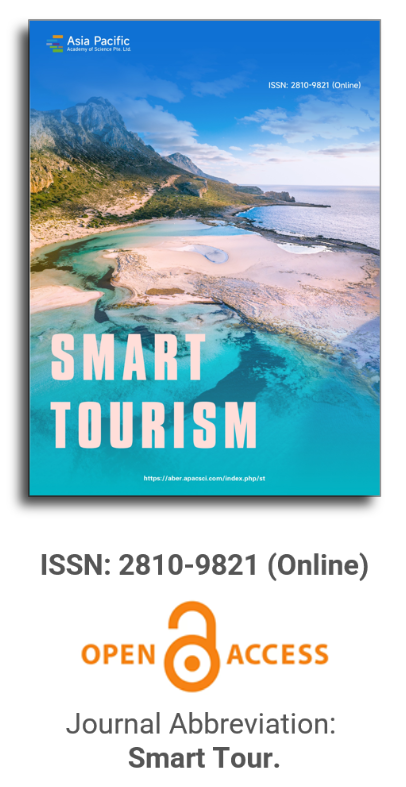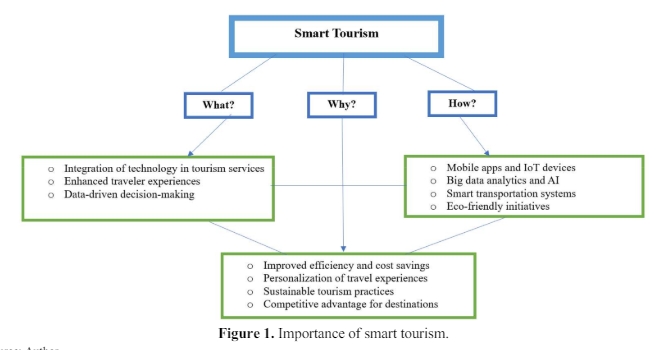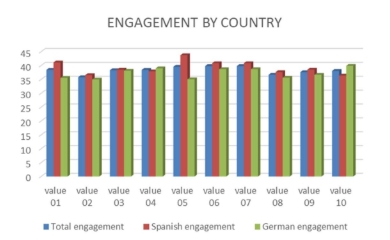


The value of intelligent services and intelligent destination: From the perspective of residents
Vol 3, Issue 1, 2022
Download PDF
Abstract
Destinations are considered brands that must be properly managed to increase not only tourist arrivals but also the quality of life of residents. Brand equity plays an important role in achieving such objectives. Simultaneously, the integration of ICT in the territory has led to the concept of “smart destinations”. In this context, the aim of the paper is to develop a value model of smart destinations from the perspective of residents (key actor of destinations as they project their image and influence the tourist experience). Our model includes smart services related to safety, health, heritage, mobility and environment. Our results confirm that smart destination value is formed by recognition, image, perceived quality and loyalty. In addition, safety, environment and mobility services are the main antecedents of smart destination value.
Keywords
References
- Boes K, Buhalis D, Inversini A. Smart tourism destinations: Ecosystems for tourism destination competitiveness. International Journal of Tourism Cities 2016; 2(2): 108–124.
- Buhalis D, Amaranggana A. Smart tourism destinations. In: Xiang Z, Tussyadiah L (editors). Information and communication technologies in tourism. Dublin: Springer 2014. p. 553–564.
- Caragliu A, Del Bo C, Nijkamp P. Smart cities in Europe. Journal of Urban Technology 2011; 18(2): 65–82.
- Falconer G, Mitchell S. Smart city framework: A systematic process for enabling smart+ connected communities. Cisco IBSG; 2012. p. 1–11.
- Vicini S, Bellini S, Sanna A. How to co-create Internet of things-enabled services for smarter cities. Stuttgart: IARIA; 2012
- Bakici T, Almirall E, Wareham J. A smart city initiative: The case of Barcelona. Journal of the Knowledge Economy 2013; 4(2): 135–148.
- Guo Y, Liu H, Chai Y. The embedding convergence of smart cities and tourism Internet of Things in China: An advance perspective. Advances in Hospitality and Tourism Research 2014; 2(1): 54–69.
- Lopez de Avila A(editor). Smart destinations: XXI century tourism. ENTER2015 Conference on Information and Communication Technologies in Tourism; 2015 Feb 4–6; Lugano.
- Gretzel U, Werthner H, Koo C, Lamsfus C. Conceptual foundations for understanding smart tourism ecosystems. Computers in Human Behavior 2015; 50: 558–563.
- Wang D, Li X, Li Y. China’s “smart tourism destination” initiative: A taste of the service dominant logic. Journal of Destination Marketing & Management 2013; 2(2): 59–61.
- San Martín H, García-de los Salmones MM, Herrero A. An integrative model of destination brand equity and tourist satisfaction. Current Issues in Tourism 2018. doi: 10.1080/13683500.2018.1428286.
- Jovicic DZ. From the traditional understanding of tourism destination to the smart tourism destination. Current Issues in Tourism 2017. doi: 10.1080/13683500.2017.1313203.
- Neuhofer B, Buhalis D, Ladkin A. Conceptualising technology enhanced destination experiences. Journal of Destination Marketing & Management 2012; 1(1/2): 36–46.
- Segittur. Smart Tourism Destinations: Constructing the future. Madrid: Segittur; 2015.
- Buonincontri P, Micera R. The experience co-creation in smart tourism destinations: A multiple case analysis of European destinations. Information Technology and Tourism 2016; 16(3): 285–315.
- Ivars-Baidal JA, Celdrán-Bernabeu MA, Mazón JN, et al. Smart destinations and the evolution of ICTs: A new scenario for destination management? Current Issues in Tourism 2017. doi: 10.1080/13683500.2017.1388771.
- Zhang L, Li N, Liu M. On the basic concept of smarter tourism and its theoretical system. Tourism Tribune 2012; 27(5): 66–73.
- Del Vecchio P, Mele G, Ndou V, et al. Creating value from Social Big Data: Implications for Smart Tourism Destinations. Information Processing and Management 2017. doi: 10.1016Zj.ipm.2017.10.006.
- Almobaideen W, Krayshan R, Allan M, et al. Internet of Things: Geographical routing based on healthcare centers vicinity for mobile smart tourism destination. Technological Forecasting and Social Change 2017; 123: 342–350.
- Wood L. Brands and brand equity: Definition and management. Management Decision 2000; 38(9): 662–669.
- Keller K. Conceptualizing, measuring, and managing customer-based brand equity. Journal of Marketing 1993; 57(1): 1–22.
- Keller, K. Strategic brand management: Building, measuring, and managing brand equity. 2nd ed. Prentice Hall: Upper Saddle River, NJ; 2013.
- Aaker DA. Managing brand equity. Capitalizing on the Value of the Brand Name. New York: Free Press; 1991.
- Yasin NM, Noor MN, Mohamad O. Does image of country-of-origin matter to brand equity? Journal of Product & Brand Management 2017; 16(1): 38–48.
- Aaker DA. Building strong brands. New York: Free Press; 1996.
- Anselmsson J, Johansson U, Persson N. Understanding price premium for grocery products: a conceptual model of customer-based brand equity. Journal of Product & Brand Management 2007; 16(6): 401–414.
- Herrero A, San Martín H, García de los Salmones M. Influence of country image on country brand equity: Application to higher education services. International Marketing Review 2016; 33(5): 691–714.
- Pappu R, Quester PG. Country equity: Conceptualization and empirical evidence. International Business Review 2010; 19(3): 276–291.
- Zeugner-Roth KP, Diamantopoulos A, Montesinos MA. Home country image, country brand equity and consumers product preferences: An empirical study. Management International Review 2008; 48(5): 577–602.
- Lucarelli A. Unraveling the complexity of “city brand equity”: A three-dimensional framework. Journal of Place Management and Development 2012; 5(3): 231–252.
- Shafranskaya I, Potapov D. An empirical study of cons umber-based city brand equity from signaling theory perspective. Place Branding and Public Diplomacy 2014; 10(2): 117–131.
- Boo S, Busser J, Baloglu S. A model of customer-based brand equity and its application to multiple destinations. Tourism Management 2009; 30: 219–231.
- Konecnik M. Croatian-based brand equity for Slovenia as a tourism destination. Economic and Business Review 2006; 8(1): 83–108.
- Pike S, Bianchi C. Destination brand equity for Australia: Testing a model of CBBE in short-haul and long-haul markets. Journal of Hospitality and Tourism Research 2013; 40(1): 114–134.
- San Martín H, García-de los Salmones MM, Herrero A. Residents’ attitudes and behavioral support for tourism in host communities. Journal of Travel & Tourism Marketing 2017; 35(2): 231–243.
- Cai A. Cooperative branding for rural destinations. Annals of Tourism Research 2002; 29(3): 720–742.
- Chen C, Myagmarsuren O. Exploring relationships between Mongolian destination brand equity, satisfaction and destination loyalty. Tourism Economics 2010; 16(4).
- Gartner W. Brand equity in a tourism destination. Place branding and public diplomacy. Special Issue: Place Brand Equity: The Concept 2014; 10(2): 108–116.
- Merrilees B, Miller D, Herington C. Antecedents of residents’ city brand attitudes. Journal of Business Research 2009; 62(3): 362–367.
- Braun E, Kavaratzis M, Zenker S. My city – my brand: The different roles of residents in place branding. Journal of Place Management and Development 2013; 6(1): 18–28.
- Herrero A, San Martín H, García de los Salmones M, et al. Examining the hierarchy of destination brands and the chain of effects between the brand equity dimensions. Journal of Destination Marketing & Management 2017; 6(4): 353–362.
- Prayag G, Ryan C. Antecedents of tourists, loyalty to Mauritius: The role and influence of destination image, place attachment, Personal involvement and satisfaction. Journal of Travel Research 2012; 51(3): 342–356.
- Wong P, Teoh K. The influence of destination competitiveness on customer-based brand equity. Journal of Destination Marketing & Management 2015; 4(4): 206–212.
- Konecnik M, Gartner W. Customer-based brand equity for a destination. Annals of Tourism Research 2007; 34(2): 400–421.
- Boo S, Busser J, Baloglu S. A model of customer-based brand equity and its application to multiple destinations. Tourism Management 2009; 30: 219–231.
- Pike S, Bianchi C, Kerr G, et al. Consumer-based brand equity for Australia as a long–haul tourism destination in an emerging market. International Marketing Review 2010; 27(4): 434–449.
- Hair JF, Anderson RE, Tatham RL. Multivariate data analysis. 7th ed. Prentice Hall: New Jersey; 2010.
- Bagozzi RP, Yi Y. On the evaluation of structural equation models. Journal of the Academy of Marketing Science 1988; 16(1): 74–94.
- Anderson JC, Gerbing DW. Structural equation modelling in practice: A review and recommended two-step approach. Psychological Bulletin 1988; 103(3): 411–423.
- Fornell C, Larcker DF. Evaluating structural equation models with unobservable variables and measurement error. Journal of Marketing Research 1981; 18(1): 39–50.
Supporting Agencies
Copyright (c) 2022 Ángel Herrero Crespo, Héctor San Martín Gutiérrez, María del Mar García de los Salmones Sánchez
License URL: https://creativecommons.org/licenses/by/4.0/

This site is licensed under a Creative Commons Attribution 4.0 International License (CC BY 4.0).

Prof. Hung-Che Wu
Nanfang College, Guangzhou
China
Indexing & Archiving
Asia Pacific Academy of Science Pte. Ltd. (APACSCI) specializes in international journal publishing. APACSCI adopts the open access publishing model and provides an important communication bridge for academic groups whose interest fields include engineering, technology, medicine, computer, mathematics, agriculture and forestry, and environment.



.jpg)
.jpg)

.jpg)

